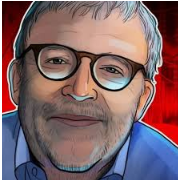Peter Brandt and I both worked for the ContiCommodity brokerage firm in the late 1970s and early 1980s. Peter was in Chicago; I was in Vancouver. Unfortunately, we never met back then, although I imagine we were in the same room more than once given all the trips I took to visit the Conti Chicago offices and the Conti people on the trading floors.
The Diary of a Professional Commodity Trader
I finally connected with Peter about five years ago after watching several of his RealVision video interviews and reading his book, The Diary of a Professional Commodity Trader. I became a subscriber to his Factor Research service back then and have continued to this day. We finally met face to face for a wonderful 2-hour visit at a Starbucks in Oro Valley, Arizona, in 2019.
Over the last five years, I’ve built a “Peter Brandt” file: full of his comments on the Trading Life and my thoughts that were inspired by his comments. I’ve been very impressed with his honesty, humility, dedication, trading success and, perhaps mostly, by his insights on how to live the Trading Life.
If you are trying to make a living as a trader or are considering such a move, I highly recommend that you read Peter’s book, subscribe to his service and watch every one of his videos on Youtube. It will be time well spent, and it will save you a lot of money and anguish!
The Pareto Principle – the 80/20 rule
Peter has frequently commented on the Pareto Principle as it applies to trading (you might know it as the 80/20 rule.) For example, Peter analyzed 27 years of his trading history (324 months) and found that ~80% of the total profits he earned during those 27 years came from less than 20% of all those months. His thought-provoking question raised by this analysis was, “If all your net profits come from only two months of the year (on average), how will you handle the other ten months?”
I asked Peter for permission to post his piece below on the differences between Trading to Make a Fortune and Trading to Support a Family. It clearly describes the motivations and consequences of choosing one trading style over another.
I believe it is hugely important for anybody who wants to live the Trading Life to examine their motivations and understand the potential consequences of their decisions. I have met many successful traders over the years, and one thing they all have in common is that they have found a way to participate in markets that suits their individual character. (None of them found their way quickly!)
Peter’s bio and contact info:
Peter Brandt is the founder and CEO of Factor LLC, a proprietary trading firm founded in 1981 at the Chicago Board of Trade. Peter is considered one of the world’s foremost authorities on using classical charting principles to trade futures, forex, and crypto markets. His book, Diary of a Professional Commodity Trader (John Wiley and Sons), was the #1 ranked financial book on Amazon for 25 weeks in 2011. Factor research is based on four pillars: classical charting principles, aggressive risk management, the process of market speculation, and the importance of human elements in trading.
The Factor research emphasizes the timeliness of classical charting principles, the centrality of aggressive risk management, the organized process of market speculation, and the under-recognized importance of the human elements.
Peter’s website is https://www.peterlbrandt.com. In addition, he has more than 500,000 followers on Twitter at: https://twitter.com/PeterLBrandt.
(I copied this essay from the Factor subscriber’s website and made some modest edits. Victor)
Trading for a Family Vs. Trading for a Fortune – By Peter Brandt
There are a lot of different reasons to engage in market speculation. My goal from inception at the Chicago Board of Trade was to make trading my career. I needed to build up an account quickly, so I took unusual risks early on. It was lucky I survived. Once I had established a decent-sized trading account (note to Newbies –it took eight years to get there), my goal was income generation. Of course, some wealth creation along the way has always been welcomed. To this day, the way I trade reflects the concept of “Trading for a Family” rather than “Trading for a Fortune.”
Along the way, I have personally known hundreds of full-time traders. Some of them have made serious fortunes trading. However, the “Trading for a Fortune” approach to market speculation is very different from a “Trading for a Family” style. Some of these people were “floor” traders, incredibly skillful at scalping hundreds of Bond or Silver contracts at a time. Others were “off-floor” traders who, as a rule, were extremely selective in being position traders –and boldly put on huge size.
The point is that one’s approach to market operation should be consistent with one’s aspirations. If you want to build a career as a trader, then approach trading as a marathon event. If you want to “make a killing”(whatever that might mean to you), then your event is the 400-meter race.
Let me make this personal –perhaps you will be able to relate. Let’s say I wanted to start all over again with the goal of turning $100,000 into $5 million in less than 10 years. How would I do it? Let me start by emphasizing that the accomplishment of this goal would be heroic. The proportion of traders who might successfully achieve this endeavour is infinitesimal. Most would either burn out or go bust, given the risks required to attain this performance. Even with my experience, I would have no assurance I could pull it off.
Following are bullet points for how I would attempt this goal as a chart trader.
•I would focus on position trading major chart themes that might take many months to play out
•I would engage in fewer than a dozen or so campaigns each year –I would need a couple of them to connect
•Weekly and monthly charts would be my focus
•Risk per trade would be much higher – perhaps 200 to 400 basis points per trading theme (Ed note: that would be 2 – 4% of total trading capital)
*Trades would be given more room, stops would not be actively advanced
*As Americans say regarding baseball, I would “swing for the fence”
•Trading frequency (events) would be cut by as much as 80% with much longer hold times than those experienced with a swing trading style
•All profits (other than tax liabilities on gains) would be retained to increase future sizing
•Draw-downs would be greater (20%-plus at least once per year)
•The emotional burden of increased sizing over time would need to be identified and managed (sizing and loss per trade in year five could be ten times as large as in year one)
If the above resonated with you, lots of luck. You will need some.
Best wishes, Peter Brandt

Subscribe: You have free access to everything on this site. Subscribers receive an email alert when I post something new – usually 4 to 6 times a month.
Victor Adair retired from the Canadian brokerage business in 2020 after 44 years and is no longer licensed to provide investment advice. Therefore, this blog, and everything else on this website, is not intended to be investment advice for anyone about anything.


